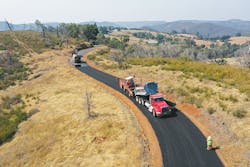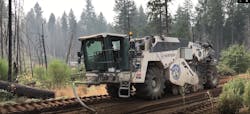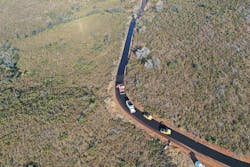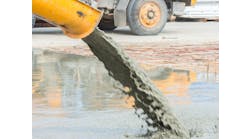Completing 16 lane-miles of full-depth reclamation for fire-damaged roadway in Calaveras County, California
By: Christopher Abel
Jesus Maria Road is a 13-mile stretch of roadway starting from Highway 26 and ending at Rail Road Flat in Calaveras County, California.
The Jesus Maria Road Rehabilitation project took place on an 8-mile stretch of this roadway, starting at Highway 26 near Mokelumne Hill and ending at Potteroff Road in Calaveras County. This 8-mile stretch of roadway is between 13 and 18 ft wide with no shoulders or pavement markings.
“It is a beautiful scenic drive, addresses roughly 100 residents, and serves as a commute or alternate commute for many other county residents,” said Chantelle Garvin, Public Works Analyst for Calaveras County.
In September 2015, a downed power line sparked the Butte Fire, burning nearly 71,000 acres—including the destruction of 877 structures resulting in the death of two individuals. The fire damaged over 85 miles of Calaveras County maintained roads, including Jesus Maria Road, a critical route used to fight the 2015 fire. The Butte Fire’s extreme heat caused asphalt cracking and melting on the affected roadways. The asphalt was further damaged by oversized vehicles responding during fire and cleanup efforts. Water and debris had infiltrated the cracked pavement and eroded the subgrade, destabilizing the pavement.
“The residents and land from Mokelumne Hill to Sheep Ranch were devastated, and Jesus Maria Road was ravished by high temperatures and heavy emergency equipment,” Garvin said. “Four years after the fire, as new growth was bringing the region back to life, and funds became available, the county, under charge of our director, Josh Pack, went into high gear to repair damages throughout the Butte Fire burn area, including the beloved Jesus Maria Road.”
In an effort to reconstruct this 8-mile stretch of roadway, a $1.66 million contract was awarded to VSS International to reconstruct Jesus Maria Road using full-depth reclamation with cement (FDR-C) and a cape seal (chip seal followed by a slurry seal). The contract had a total of 25 working days to complete the work.
Before work began on the reconstruction, a Stormwater Pollution Prevention Plan (SWPPP) was developed and implemented on site to protect the Upper Mokelumne River and the North Fork of the Cosumnes River; both being high risk receiving watersheds. VSS International hired Tully Group to develop the SWPPP Plan and conduct SWPPP inspections on BMPs placed by VSS International.
Another discovery made during the preconstruction phase was that the sizable equipment used for the FDR-C, chip seal, and slurry seal operations along with the winding and narrow roads made it nearly impossible to consistently flag residents through working areas in a safe manner. Temporary road closures were used along with flagging operations to keep residents and workers safe throughout the construction area, per the Manual on Uniform Traffic Control Devices (MUTCD). Using radios, flaggers and other crew members were able to successfully hold traffic until it was safe to allow the traveling public through the area or allow traffic to use a detour to an adjacent road. Road closure applications were submitted to the county along with site-specific traffic control plans developed by Statewide Safety Systems.
An additional challenge that needed to be addressed during the preconstruction phase was developing a water supply to the project site. Due to the potential for water hammer with hydrants near the project site, VSS International developed a water supply using the Calaveras County bulk water card lock system and water trucks to haul water. This was essential to the success of the project.
After all BMPs were placed, traffic control plans were submitted, and road closure applications were turned in to the county, complete reconstruction of Jesus Maria Road could begin.
VSS International partnered with Pavement Recycling Systems (PRS) to perform the FDR-C on the existing roadway. The FDR-C portion of this project was originally due to start in August 2020, but due to cement shortages caused by the economic conditions of the time—with supply shortages and COVID-19 pandemic—the start date was delayed until September. Before FDR-C operations commenced, a mix design was submitted to the county to determine the optimal spread rate and pulverization depth for the FDR. The FDR-C of Jesus Maria Road started on the five-year anniversary of the Butte Fire. This was the fire that caused the road to be in its previous state of disrepair. Working in a dry area prone to fire danger, special precautions were made to ensure there would not be a repeat of the previous fire that burned over 70,000 acres in the area.
The entire FDR area was measured to be approximately 78,360 sq yd. The work consisted of spreading cement on existing asphalt surface at a rate determined by the mix design, mixing cement and water with existing asphalt and base to a depth of 9 in., followed by grading and final compaction. At the end of each week, a fog seal coat was applied to the FDR-C surface to prepare for the final cape seal process. The FDR-C process took 15 days to complete, meeting the predetermined schedule.
Following this process, VSS International’s crews placed a conventional chip seal over the FDR surface. The chips used were 3/8-in. washed chips from George Reed’s Table Mountain Quarry and the emulsion was a polymer modified CRS. The 78,360 sq yd FDR-C was covered with chip seal in only two days using approximately 950 tons of 3/8-in. chips and 95 tons of polymer modified CRS emulsion supplied by VSS Emultech.
To complete the reconstruction of Jesus Maria Road, VSS International then placed a slurry seal over the top of the previously laid chip seal. This process, known as a cape seal, provides the benefits of both the chip seal and the slurry seal treatment, namely sealing moderate cracks, providing skid resistance, sealing the pavement against moisture intrusion, protecting the structure from oxidation and raveling, and restoring a uniform black appearance. The 78,360 sq yd of slurry seal was laid over four days with approximately 550 tons of type 2 slurry seal aggregate from George Reed Table Mountain and over 80 tons of PMCQS-1h emulsion supplied by VSS Emultech.
All phases of work were planned and communicated with the public through two-week and 72-hour notifications before crews would temporarily close a section of Jesus Maria Road. Final striping was completed by the county’s desired completion date. The excellent communication combined with on-time completion of the project led to overall success.
By choosing FDR-C with a cape seal, Calaveras County saved $2,244,985. This is 73% less than a full-depth remove and replace with hot-mix asphalt (HMA). This process also reduced greenhouse gas emissions by over 80% compared to a full-depth remove and replace with HMA.
According to Garvin and Calaveras County authorities, “This was the county’s first full-depth reclamation project. California Nevada Cement Association was helpful in providing reference projects as well as technical assistance. There were no major problems from start to finish. The county also won the 2020 Excellence in Contracting Award from Western Regional Association for Pavement Preservation. Overall, the project was a major accomplishment for the county but felt relatively effortless. It was a great team effort and both VSS International and Pavement Recycling Systems were a pleasure to work with. Jesus Maria looks beautiful and drives beautifully, and, if maintained, will last the residents a very long time.”
About The Author: Abel is project engineer for VSS International Inc.



